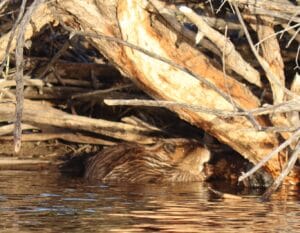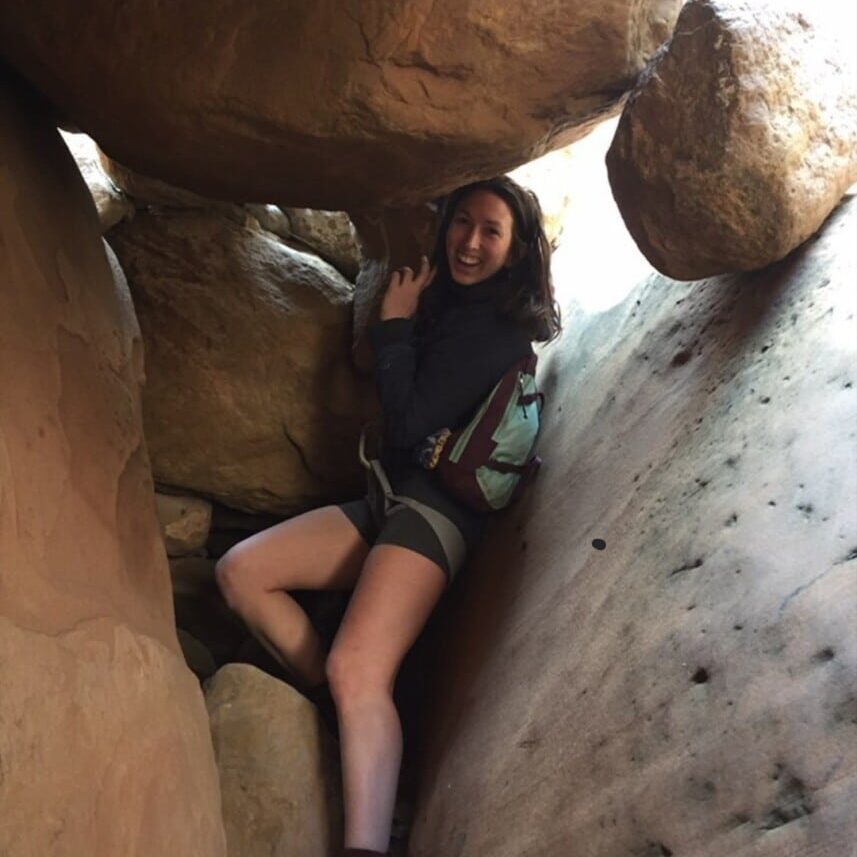I spoke with Jenny, an artist and Lander resident who has horses that rely on the river running through their pasture for water. Last year a beaver decided that this stretch of river was fantastic habitat and started building a dam. At first, Jenny was not too bothered. In fact, she was curious. She felt a connection to the inventive nature of the beavers and interacted with them by learning more about their ecology. Beavers’ main structures consist of a food cache, lodge, and dam. Each of these structures is unique and serves the beaver family a different purpose. The structure that Jenny struggled with that next winter was the dam. “The water coming around was higher and would freeze at night. I had a frozen waterfall on my only horse watering access.”

Wyoming has a lot of dry lands. It’s part of its own necessary sagebrush steppe ecosystem and is critically important to the hundreds of plant and animal species that live in it. Dry land creates space for homes to be built, cattle to graze, and roads to span.
As excellent ecosystem engineers, which is what biologists call animals that built environment-altering modes of survival, humans are really good at making dry land. We build incredible infrastructure that puts water in convenient places: one place for the water, and one place for us. We’ve created laws covering who gets how much water and laws about why they get to use that water.
An ecosystem engineer that we forgot to consult is the beaver.
What Do Beavers Do?
Beavers were stewards of the water long before the colonization of the Americas. Much like how a sunset just can’t seem to get colors wrong, beavers are nature’s delicate puzzle piece it has cultivated to slow water down and blur the edges between dry land and rivers. This relationship is what gives us lush floodplains and green, grassy aspen forests.
Beaver dams are the engineer’s mode of food cultivation and shelter. They are sculpted to the finest detail and are works of art to be adored if you happen upon one. They take water that would otherwise shoot straight through an area and slow it down, letting it seep out to the thirsty roots of the surrounding vegetation. The beavers can then watch their food sources grow on their front doorstep.
Although beavers eat willows, aspen, and other wetland plant species, these are the species that also benefit from the beaver’s ponds that soak new ground and enable them to grow in new areas. These plants grow a dense matrix of roots over time that trap water in an ecosystem – think of it as a bank, saving up water for a dry day. This same matrix also makes river banks hardier against cattle traffic by slowing down erosion and giving the cattle something structured to stand on. The more of these wetlands we have, the more resilient food sources we have for the diverse fish and game found in Wyoming. Through our own styles of water infrastructure and historical trapping practices that significantly lowered their numbers in Wyoming, we have altered the way water moves through the landscape. Getting these animals back into the environment means they can get to work rebuilding habitat we have lost. In a changing environment that could face higher rates of drought, this is more crucial than ever.
Joanna Harter is an aquatic habitat biologist with Wyoming Game and Fish Department who found Jenny’s situation interesting and enjoyed working with her on the issue. Although WGFD is limited in time and resources available to devote to nuisance beaver calls, talking with a habitat biologist can be helpful. Joanna has not directly intervened with the dam but did go out to look and discuss options. She told me Jenny found that creating and maintaining a notch in the side of the dam to let water through was helpful, although this is not the perfect resolution for every case since the beavers may repair holes in their dams as quickly as overnight. Joanna made it clear to me that Jenny making the best of her new beaver neighbor was the best-case scenario, though. When someone decides to embrace the idea of sharing space with beavers, “Every situation with a beaver is different and there’s not necessarily a perfect solution to apply to each one. Sometimes you have to try a few times to get it right at your location.”

Removing a beaver should be a last resort, says Joanna. She makes it clear that WGFD tries to focus on the situations where there is no other option, and in many cases, it is illegal to handle or move a beaver even it if is on your property. A study conducted in Wyoming concluded the mortality rate of transplanted beavers can be up to 50%, although researchers are continually looking into new options to raise the success rate. Beavers tend to create dams in what is already good beaver habitat - getting rid of a beaver will only be a solution for so long until another one moves in. Some options that Joanna suggests if dams cause problematic flooding on your property or you are concerned for trees are:
- An off-channel watering source for overgrazing or bank erosion concerns
- Riparian fencing to keep beavers out of certain areas
- Tree protective coverings like fencing or sand paint
- Water flow devices like beaver deceivers and diversion dams
Recent studies conclude almost 100% success of water flow devices where they are applicable, but Jenny's horse watering access was not suitable for them and she desperately did not want to remove the beavers.
Why would keeping a beaver around be a good thing?
According to Jenny, the beavers were making the area fuller and greener. “They were making a beautiful pond and water storage. They brought a lot of trees down, but there are a lot of young trees still coming up.” Also, coexisting with a fellow ecosystem engineer can be an interactive process. Installing water flow devices can be fun and allow you to shape your land in creative ways. Witnessing drastic habitat changes that come along with beaver dams can be educational and engaging, and the ponds that form make great fishing holes. Beaver mitigation systems can also be much lower in cost and effort than repetitively removing beavers every time they show up. Removing a beaver should serve as a last resort only, and puts a “free real estate” sign up for the next beaver that will come along. Recently, a cost-sharing option has opened to Wyoming residents who feel they need help covering the expense of protecting trees and installing beaver deceivers.
In terms of ecosystem health, Joanna says that beavers are key. “Beavers provide a lot of ecosystem services that people aren’t aware of. They are creating wetland habitats, diverse fish habitats, and moderating stream temperatures. They serve as an oasis for animals after wildfires too. You’ll see black everywhere in the forest but by the water, there will be bright green, and only where there are beavers.” She says that in most cases that she’s seen rivers go through phases where the dams will create a higher water level, enrich the ground and allow for aspen and cottonwoods to take roots and grow, then recede back to their previous state. For many folks in Wyoming, having an established source of shade in their backyards is highly desirable.
Jenny shared with me that the beaver family persists in the horse pastures, and she still appreciates them with the same ferocious admiration. “I started researching, and once you do you end up in this black hole,” she said while showing me her collection of beaver artwork that she creates. Her vision is to sell this collection and use the funds as donations towards regional beaver conservation efforts. Settling a dispute between two ecosystem engineers can be difficult, but when some creativity and curiosity is put forth, the ecosystem we both live in prospers.
If you want to help out with Jenny’s cause, you can contact the Sweetwater Studio in Lander.
About the AUthor

Cassidy Downing is a runner, artist, and passionate conservationist. She hails from Detroit, but now calls Wyoming home where she actively pursues avenues of conservation science and outreach. Cassidy received her BS in Ecology at Northern Michigan University and is now a Wyoming Wildlife Federation Intern and a volunteer software coder with The Nature Conservancy’s Conservation Data Lab. She enjoys wetting some flies on a slow afternoon in the Wind River Mountains ever in pursuit of that perfect cutthroat trout, scouting fields with a wildflower ID book in-hand, and exploring the rich local cultures Wyoming has to offer.
